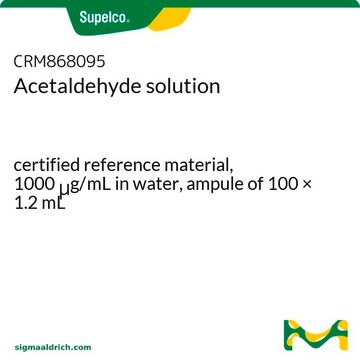719099
Acetaldehyde solution
5 M in THF
Autenticatiper visualizzare i prezzi riservati alla tua organizzazione & contrattuali
About This Item
Formula condensata:
CH3CHO
Numero CAS:
Peso molecolare:
44.05
Numero MDL:
Codice UNSPSC:
12352100
eCl@ss:
39021102
ID PubChem:
NACRES:
NA.22
Prodotti consigliati
Stato
liquid
Livello qualitativo
Concentrazione
5 M in THF
Indice di rifrazione
n20/D 1.389
Densità
0.868 g/mL at 20 °C
0.843 g/mL at 25 °C
Gruppo funzionale
aldehyde
Temperatura di conservazione
2-8°C
Stringa SMILE
[H]C(C)=O
InChI
1S/C2H4O/c1-2-3/h2H,1H3
IKHGUXGNUITLKF-UHFFFAOYSA-N
Cerchi prodotti simili? Visita Guida al confronto tra prodotti
Avvertenze
Danger
Indicazioni di pericolo
Consigli di prudenza
Classi di pericolo
Carc. 1B - Eye Irrit. 2 - Flam. Liq. 2 - Muta. 2 - STOT SE 3
Organi bersaglio
Central nervous system, Respiratory system
Rischi supp
Codice della classe di stoccaggio
3 - Flammable liquids
Classe di pericolosità dell'acqua (WGK)
WGK 3
Punto d’infiammabilità (°F)
-25.1 °F - closed cup
Punto d’infiammabilità (°C)
-31.7 °C - closed cup
Scegli una delle versioni più recenti:
Possiedi già questo prodotto?
I documenti relativi ai prodotti acquistati recentemente sono disponibili nell’Archivio dei documenti.
I clienti hanno visto anche
Nikoline Borgermann et al.
The EMBO journal, 38(8) (2019-03-28)
DNA-protein crosslinks (DPCs) are highly cytotoxic lesions that obstruct essential DNA transactions and whose resolution is critical for cell and organismal fitness. However, the mechanisms by which cells respond to and overcome DPCs remain incompletely understood. Recent studies unveiled a
M Becker et al.
Journal of chromatography. A, 1281, 115-126 (2013-02-13)
Gas chromatographic analysis of complex carbohydrate mixtures requires highly effective and reliable derivatisation strategies for successful separation, identification, and quantitation of all constituents. Different single-step (per-trimethylsilylation, isopropylidenation) and two-step approaches (ethoximation-trimethylsilylation, ethoximation-trifluoroacetylation, benzoximation-trimethylsilylation, benzoximation-trifluoroacetylation) have been comprehensively studied with regard
Marjie L Hard et al.
Placenta, 24(2-3), 149-154 (2003-02-05)
Significant interindividual variability exists following maternal alcohol consumption; not all children born to alcoholic women manifest the symptoms associated with foetal alcohol spectrum disorder (FASD). To investigate the potential role of the placenta as a source of variability by determining
Tetsuji Yokoyama et al.
Alcoholism, clinical and experimental research, 29(4), 622-630 (2005-04-19)
Elevated mean corpuscular volume (MCV) is a traditional biological marker for alcohol abuse and alcoholism, but the underlying mechanism is unclear. Three recent epidemiologic studies consistently showed that MCV was elevated by alcohol drinking more markedly among individuals with genetically
Dirk W Lachenmeier et al.
Addiction (Abingdon, England), 104(4), 533-550 (2009-04-02)
In addition to being produced in ethanol metabolism, acetaldehyde occurs naturally in alcoholic beverages. Limited epidemiological evidence points to acetaldehyde as an independent risk factor for cancer during alcohol consumption, in addition to the effects of ethanol. This study aims
Il team dei nostri ricercatori vanta grande esperienza in tutte le aree della ricerca quali Life Science, scienza dei materiali, sintesi chimica, cromatografia, discipline analitiche, ecc..
Contatta l'Assistenza Tecnica.






